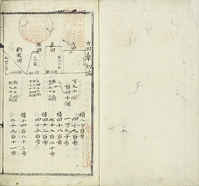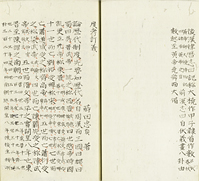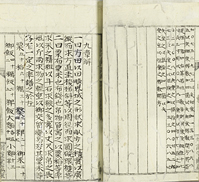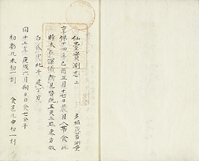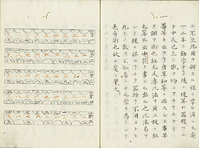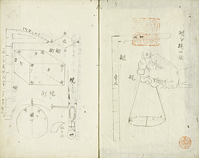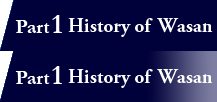5. Introducing Overseas Knowledge
This section introduces materials related to knowledge that was imported from overseas and incorporated into Wasan.
As knowledge imported from China was largely respected before the introduction of Western mathematics, some materials based on the knowledge transmitted from China are also exhibited here.
Also, we exhibit a material (Sendai jissoku shi) related to Toita Yasusuke, who was very enthusiastic about introducing Western mathematics, and materials that directly introduce Western mathematics.
Mathematics Derived from China
1 Sankei kyusho
Ms. 1 v. <139-111>
This is a manuscript whose author and completion year are both unknown. "Kyusho" (meaning nine chapters) in the title refers to what is derived from summarizing the items of the traditional Chinese mathematics from ancient times. Its chapter structure follows that of a textbook called Jiuzhang suanshu (Nine chapters on mathematical art), an old Chinese mathematical book. (The nine chapters are "Fang tian" (Field measurement), "Su mi" (Cereals), "Cui fen" (Distribution by proportion), "Shao guang" (What width?), "Shang gong" (Construction consultations), "Jun shu" (Fair taxes), "Ying bu zu" (Excess and deficiency), "Fang cheng" (Equations), and "Gou gu" (Right triangles). It includes area calculations of fields, volume calculations of solids, proportional expressions required for trade, calculations of square and cubic roots, linear simultaneous equations, problems of right triangles, and so on.)
Jiuzhang suanshu is a textbook that was mainly compiled from arithmetic operations bureaucrats required in sites of administration, although it also includes general problems of arithmetic. It was completed around the first century AD and had been regarded as a model of subsequent mathematical textbooks. There is evidence that the book was imported to Japan in the Heian period, but it was simply forgotten and transmitted again to Japan in the Edo period.
However, this book does not follow the original Jiuzhang suanshu. It arranges exercises, numerical tables, etc., in the form of a memorandum, based on the content of "Jiuzhang" (i.e., the nine chapters). (We many notice a few mistakes such as wrong calculations.) It is a material that shows that Wasan also had an aspect of being conscious of the Chinese "nine chapters."
2 Sangaku hiyo
By Makita Ganmon. Ms. 1 v. <わ419-2>
This book comprises miscellanea related to systems of weights and measures, calendars, and arithmetic. It arranges in random order typical exercises of the "Nine Chapters" in the mathematics of ancient China, the tengenjutsu equivalent to equations, excerpts from Katsuyo sanpo by Seki Takakazu (?-1708), and so on. Many items included in the book were extracted from Chinese classical mathematical books. Some sections include quotations from Wasan books in Japan. Among those, Doko teigi by Makita Ganmon (Tadasada) is included. (The other sections lack authors' names.)
Makita (?-1850), whose name is mentioned in the book, was a scholar of the Chinese classics who belonged to the Fukui Domain. He went to Osaka and engaged in various activities such as opening a private school for a while. From what we can see in these miscellanea, we could infer that he had quite an interest in calendars and arithmetic. This book can be classified as a memorandum for the information required for scholars of the Chinese classics.
3 Sugaku shoho
By Makita Ganmon. Ms. 1 v. <わ419-3>
This book also comprises miscellanea by Makita similar to the one in the previous section. It has a preface, and leaves evidence of corrections. It does not seem to be a completed manuscript.
It describes topics of arithmetic in Japan and in China as a memorandum in random order, including explanations of the "Nine Chapters" as the arithmetic of ancient China, a list of mathematical books left in records of the successive dynasties in China, and a list of values of Pi per arithmetician.
Western Knowledge and Mathematics
4 Sendai jissoku shi
By Toita Yasusuke. Ms. 2 v. <139-62>
The author Toita Yasusuke (1708-1784) was a scholar of Wasan and calendars, belonging to the Sendai Domain. At the time of the calendar reform project during the Horeki era, he took his post in Kyoto by order of the Sendai Domain, met Yamaji Nushizumi (1704-1772) who was a Wasan scholar in the Seki school and employed by the Shogunate Tenmonkata, and pursued studies in the school. In connection with such a background, Toita was imparted with many Wasan books of the Seki school, and devoted his life to the compilation of Sekisan shidensho until the latter stage of his life after he returned home. In addition to Wasan, Toita compiled a series of books on astronomy and calendar studies, and completed Sutei ruisho, Tenmon hisho, and other books.
This book summarizes observation records of the solar and lunar eclipses Toita actually measured in Sendai, and numerical tables required for astronomical observation. It covers the periods from Kyoho to An'ei (1729 to 1780), and is regarded as a valuable record of continuous observations by a local astronomer. The exhibited book is the book manually copied by Obata Chutatsu, a Wasan scholar in Oshu Mizusawa.
5 Chusan shiki
By Arisawa Munesada. Ms. 1 v. <140-210>
The author Arisawa Munesada (1689-1752) was a strategist serving under the Maeda clan in the Kanazawa Domain. He showed a great deal of interest in surveying and the art of arithmetic, and left many works related to these topics.
This book Chusan shiki is a commentary on Napier's bones, a kind of abacus developed in Europe. As it enabled multiplications and divisions to be handled freely by the placement of the rods, it was regarded as a very useful tool in the West. Its knowledge was imported from China to Japan via Nagasaki. Arisawa writes something to the effect that as calculation by soroban was a lowly technique used by merchants, samurai ought to use Napier's bones for calculation. The book tells us under what impression the mathematics derived from the West was imported by the then Samurai class.
6 Konpasu yoho
Ms. 1 v. <181-278>
This is a manuscript whose author and completion year are both unknown, and it is believed that it was manually copied from the second half of the eighteenth century to the nineteenth century.
It randomly describes drawing figures with a pair of compasses, sketches with a Western perspective, the latitudes and longitudes of the earth, survey methods, etc. Particularly, the drawing method using a pair of compasses was a topic that most Wasan scholars did not deal with, and we can infer that the author had a great deal of interest in Western knowledge. From the fact that these manuscripts remain, we can understand that there were some scholars who were not solely obsessed with things Japanese among the Wasan scholars.

